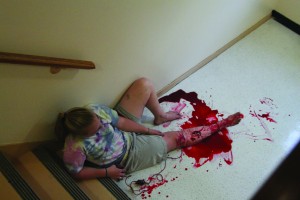Coinciding with water problems and outages, faculty will be meeting with the Board of Trustees this Friday, February 14 to finalize an emergency response plan. The plan, which covers emergency situations ranging from bomb scares, electrical outages, floods, and hazmat spills, details a communications plan amongst faculty and responders in the community in the event of an emergency situation. Dr. Robert Pool, vice president for student life and head of the emergency plan, describes the plan as allowing for a “coordinated response” amongst faculty and staff on campus.
 The changes to the plan, which was partially reworked by previous vice president Sharra Hynes, includes new protocol on active shooter scenarios and “some new information in ways to handle suicide, death threats … serious injury of a community member,” according to Pool. Also added to the plan was a piece drawing on support from Sodexo, which provided that in the event of a disaster preventing those on campus from leaving and blocking outsiders from entry to campus, an extra few days’ supply of food would be kept on hand for rationing.
The changes to the plan, which was partially reworked by previous vice president Sharra Hynes, includes new protocol on active shooter scenarios and “some new information in ways to handle suicide, death threats … serious injury of a community member,” according to Pool. Also added to the plan was a piece drawing on support from Sodexo, which provided that in the event of a disaster preventing those on campus from leaving and blocking outsiders from entry to campus, an extra few days’ supply of food would be kept on hand for rationing.
These changes coincide with two water pipe breaks over the past month, as well as separate internet and power outages in the past few weeks.
The internet outage, which occurred between 11:28 am and 2:48 pm on January 29, was campus-wide. While internal services such as Moodle and faculty email worked for those on the campus internet connection, the outage left the campus cut off from internet communication with the outside world. According to Don Haingray, director of technology services, the outage was caused by a hardware issue on the end of ION, the company which set up the fiber route through which the college gains internet access. ION, which operates more than 2200 miles of fiber optic cable across New York state, is currently working on establishing a dual fiber route in the state’s southern tier, which would allow internet customers to rely on a second cable for service in case of damage to one. Also affected by the outage was Alfred University, which relies on the same route for internet access.
While tech services does have a single cellular modem used for troubleshooting, there are no alternate internet connections capable of servicing the entire campus. Erin Bard, network administrator, even stated that “one of the problems that I noticed at the time, trying to use [the modem], was that Verizon was having issues as well.”
Also of recent interest was a campus-wide power outage, which occurred February 3 at around 5:40 am. The main cause of the outage was a blown transformer at a nearby substation belonging to Rochester Gas & Electric. In addition to the college campus, the outage also affected residents in Fillmore, Houghton, and parts of other surrounding towns. However, power was restored within an hour of the beginning of the outage.
With more serious outages in mind, Pool states that the college keeps two main generators on hand for backup, one which powers the Paine science building and another which powers the Nielsen athletic center. Haingray also adds that there is a backup generator available to tech services to keep servers running during an outage.
Regardless of any effects of internet and power outages on campus, Pool states that communication of any emergencies to students will still be made via phone calls and text messages. Using software from the Wireless Emergency Notification System (WENS), students may opt to sign up for emergency notifications sent out by the college. As such notifications are sent from offsite, they would not be affected by an outage on campus.
The operation of WENS on campus, which is overseen by Ray Parlett, director of safety and security, is stunted by the fact that only 25 to 30 percent of students are signed up for the service. The service is one of the main tools used in a situation of an urgent or emergency nature. Said Dr. Pool, “We were almost to that point last week when the power went out, but … within 10 minutes it was back up. So, we didn’t have to institute the WENS notification system.”
Also laid out in the emergency response plan are procedures for fires, most of which were tested in a comprehensive drill in Gillette Hall last semester. The drill, which used fog machines and resident actors with imitated injuries and called in emergency responders from the area, proved to be an overview of the competence of the college’s emergency responders. Parlett, the coordinator of the drill, explained that the college worked with “the fire department, ambulance [services] from Houghton, but they brought in Fillmore, and they might have brought in some folks from Hornell and Belfast as well. We worked with the Allegany county emergency services department … and we worked with the state police, who were there for observational purposes. We actually had a couple of fire investigators on the scene for investigational purposes as well.” Faculty involved in the emergency response plan were also present on the scene “to work through some of the exercises” as Parlett explained.
As for the outcome of the drill, Parlett stated that “in terms of the actual response, I was pretty encouraged.” The smoke alarms responded to the smoke “quicker, two or three minutes quicker than I thought” The local fire department also responded “within seven or eight minutes [and] … had a truck up here for an initial response.” According to Parlett, all residents were successfully evacuated by the fire department, including those planted in the building with simulated injuries. The only weak point highlighted by the drill was a glitch in the WENS program which prevented emergency notifications from reaching about a dozen of the faculty. Since then, the issue has been fixed.
According to Dennis Stack, dean of students, “by law, we need to do one type of drill per year, although it can be something called a ‘tabletop,’ which is more of a theory-driven drill of something that could happen,” adding that “we are actually looking at another scenario for maybe even this spring.” Pool added that while months of training might help in preparation, “you’re never perfectly prepared for what’s going to happen.”

